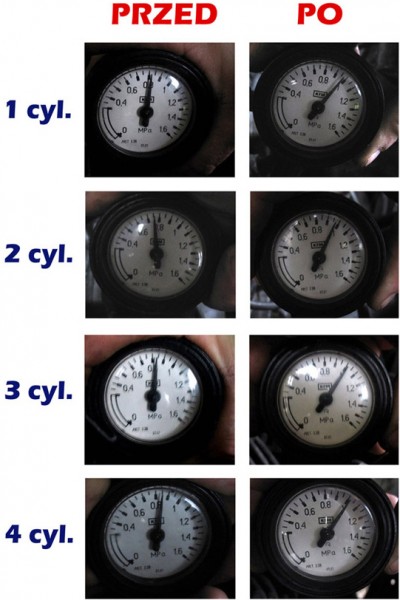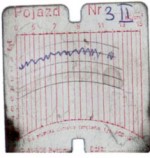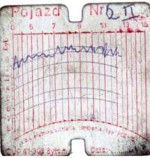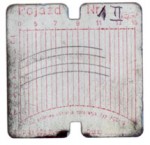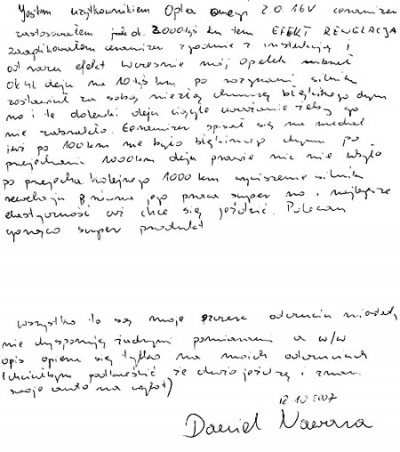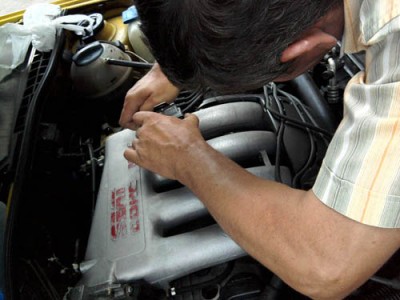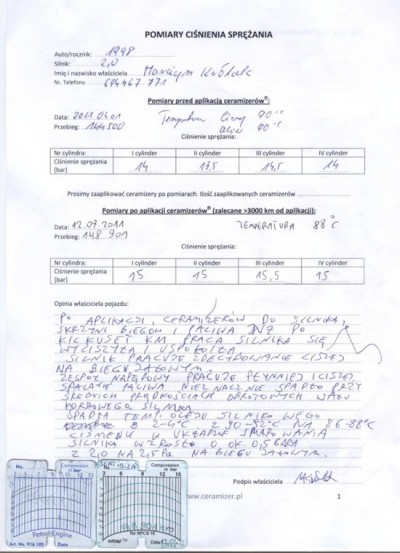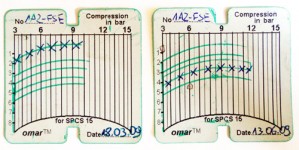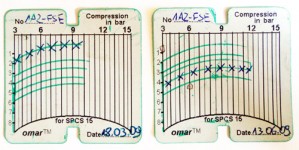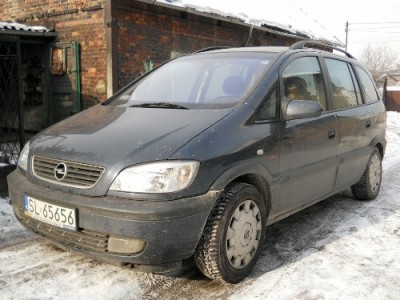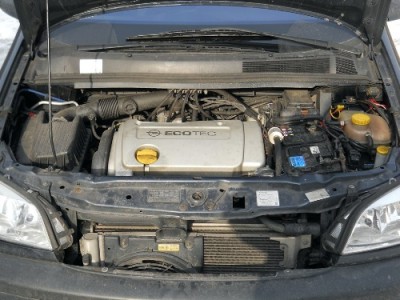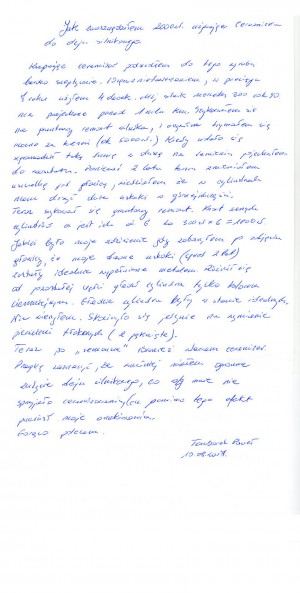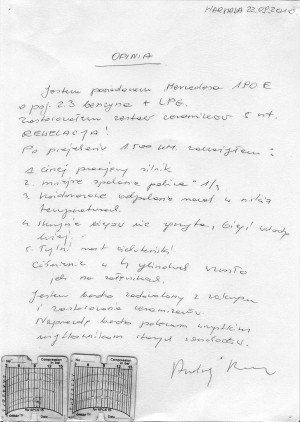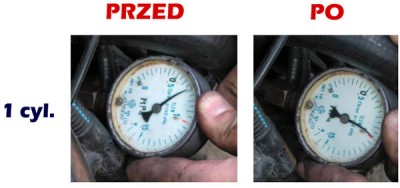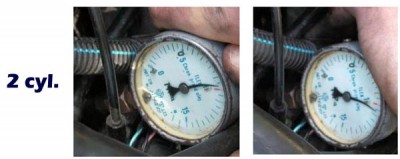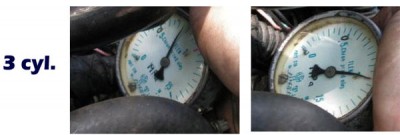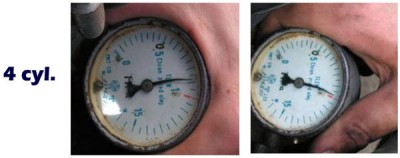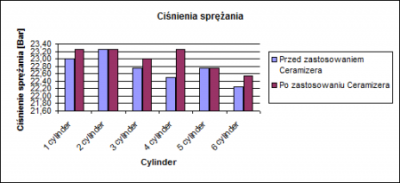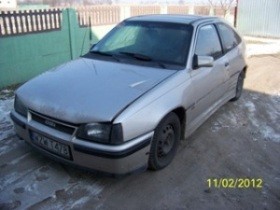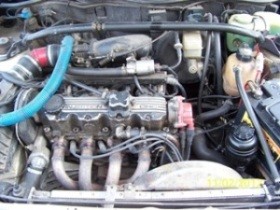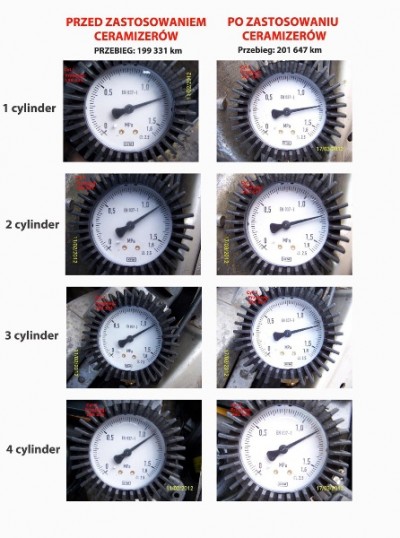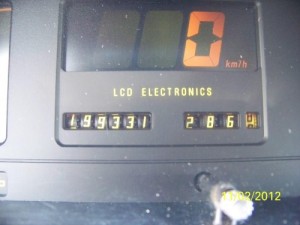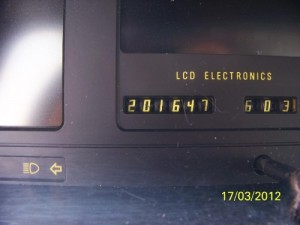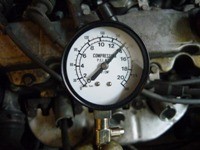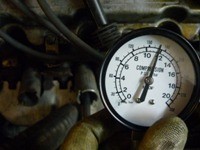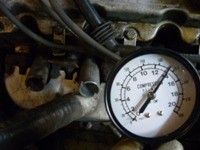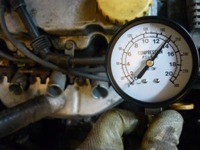Ceramizers are preparations that regenerate and protect m.in. engines, gearboxes, rear axles and fuel efficiency reduction. We have received a lot of feedback from people who have used the preparation in their vehicle: all reviews (245 pages, PDF format) – after clicking wait a few seconds, the file is quite large.
Are you a Ceramizer user?
We reward reliable opinions with any selected Ceramizer (opinions in text form) or any selected set of Ceramizers (video reviews).
Opinions divided by vehicle brands
The most interesting opinions, divided by application in the vehicle
- Opinions on the use in engines
- Reviews on the use in the gearbox
- Feedback on use in the power steering system
- Opinions on the use in motorcycles
- Regeneration of DPF and FAP filters
- Negative feedback and our responses
Video reviews
Opinion after the use of Ceramizer in Toyota Yaris 1.0
Opinion of the mechanic
Opinion on the use of Ceramizer in Ford Focus Mk2
Opinion on the use of Ceramizer in the Honda XBR500 motorcycle
See all video reviews
Some of the most interesting opinions in text form
Marcel Gajda
Renault Fuego
Year of Build: 1982
Engine size: 2.0
Opinion: To be honest, I approached the subject of ceramizers with great distance. I was prompted to use it by the opinion of a mechanic who admitted that he uses it in many cars successfully.
I decided to use it because I wanted to see for myself the properties of the preparation, the car I have is not too expensive so in case of the negative impact of ceramizer I would not be sorry for it, but if it actually worked I would use it in other vehicles that I have. The car on which I wanted to test the preparation took oil about 1L / 5000km and kicked a little, it also walked quite loudly. He drove over 200 kkm.
Before applying the preparation, I changed the oil and carried out measurements about 1000km after replacement to eliminate the possible influence of oil on the measurement. The next measurement I carried out after 3000km to my pleasant surprise the pressure increased by about 2 bar and leveled on all cylinders. In addition, after driving 4000km, the oil level on the bayonet decreased to such an extent that I think that I will not have to add it to the next replacement. Of course, it does not kick now and works quieter, it also seems to me that the car has gained in dynamics. In a word, saying something in these ceramizers must be true since my measurements and feelings indicate that the ceramizer significantly refreshed the engine of my car.
Marcel Gajda
Zbigniew Morgowski
My adventure with ceramizers began about a year ago. I bought a Peugeot 405 with a 1.8l.mileage on the odometer was about 365 000km. A little much,but the price was attractive,so I took a chance. As it turned out later after changing the oil, the engine began to knock:(,None of the mechanics was able to help me, almost everything was replaced, from the shells to the timing shaft. Oil is just taking, 3l per 1000km. I measured the compression pressure, well it was not so bad because it was respectively 11.3 11.5 12.0 11.8.
I was looking on the Internet what you can do to change it??? I found a ceramizer and applied at risk. I drove about 2000km, the oil surprisingly settled at 250ml per 1000km, it was just sensational, the car became more snappy and better ignited, again I measured the compression pressure at the same mechanic on the same device, it was respectively 12.1 11.9 12.2 12.0, it was not bad but the engine knocked terribly especially on the cold. The mechanic advised me to remove the heads and see what was happening???
Well, it turned out that the first sleeve was so strongly made that the piston knocked, after measuring the diameter it was 0.3 millimeters is already rubble, but that I could not afford the renovation, we assembled it as it was. I thought nothing but need to collect on the bushings. But the value of the car was small, so I was wondering what to do??? He got the next dose of ceramizer, after driving the next 2000km, I made a measurement,12.5 13.0 13.0 13.0 and to my surprise the knocks were smaller.
I got the bushings and tormented the mechanic to replace it. After removing the head it turned out that there is no making, hmmmm it was amazing, The measurement with a diameter showed the level of about 0.04 of the workmanship, ceramizer filled almost the entire manufacture of the sleeve which was suitable only for replacement, Thank you inventors, for such a wonderful remedy. Today I advise everyone and my mechanic who laughed at ceramizera, believed, because all I did was watch. I sent the bushings to Warsaw, in accordance with the request, Let it become a material for further research and better use of the product properties. Thank you and Regards
Zbigniew Morgowski, Żary
Daniel Nawara
I am an Opel Omega 2.0 user. 16V. Ceramizer I used approx. 2000 thousand km ago. REVELATION EFFECT. I applied ceramizer according to the instructions and immediately the effect. Previously, my Opelek took approx. 4l of oil for 10,000 km after warming up the engine left behind a nice cloud of blue smoke and these oil refills constant care that it was not missing. Ceramizer did a great job after 100km there was no blue smoke after driving 1000km of oil almost nothing was lost after driving another 1000km engine silence equal to its great work and the best flexibility until you want to ride. I highly recommend a great product. All these are my sincere feelings, unfortunately I do not have any measurements and the above description is based only on my feelings (I would like to emphasize that I drive a lot and I know my car inside out).
Daniel Nawara, 12.10.2007
Miroslaw Andrzejak
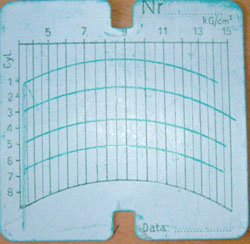
I would like to share the results of measurements made in the car Ford Mondeo 1.8 gasoline 16V, mileage before applying the preparation 151440 km, (it is difficult to say whether this is the original mileage). After passing the recommended approx. 1500 km at 153030 km the results of measurements on the same instrument were:
| Meter status | Distance from application time | Cyl 1 | Cyl 2 | Cyl 3 | Cyl 4 |
| 151440 km | 0 | 11 | 7 | 10 | 11,5 |
| 153030 km | 1590 | 14,1 | 15,3 | 14,6 | 14,5 |
For me this is a revelation, Ceramizer not only raised the compression pressure on all cylinders, but on the second cylinder it raised by more than 100%. A mechanic friend who did this couldn’t believe it. It seems to me that such compression pressures have nominal engines. The results of measurements after 1590 km from the application of the preparation are presented in the photo.
Best regards
Miroslaw Andrzejak
72-001 Kołbaskowo 91/4
Date of receipt of the opinion – 04.05.2005
Further feedback: After pouring the agent on the first ride, you could hear the quieter operation of the engine. After driving the first time approx. 130 km at a standstill the engine was audible almost like a fan, it really worked very quietly and evenly. I thought then that there must be something in it and I was looking forward to the final measurement after these 1500 km. Later, with the passage of kilometers, it seemed to me as if the car was more agile while driving, and I think it remained so. And I am most pleased with the fact that the preparation compensated me for this weak compression pressure on the 2nd cylinder.
Regards, satisfied, Mirosław Andrzejak
Suzuki Swift
Year of Build: 2008
Engine size: 1.3
Mileage: 85000km
Definitely noticeable quieter and more even engine operation. The engine works lighter, accelerates more briskly, fires more easily and burns less (I also used Ceramizer for fuel). Before that, it happened from time to time that in the morning I had problems with firing. Now there is no problem with this:) I also applied Ceramizer to the gearbox, which worked hard and “hummed” – a definite improvement after driving approx. 2.000km on Ceramizer.
Richard Golla
Opinion sent on 25/11/2013
Seat Ibiza Cupra
Auto/year: 1998
Engine: 2.0
Mileage: 148.901 km
After the application of Ceramizers to the engine, gearbox and fuel, after just a few hundred km, the engine work became quiet and calmed down. The engine runs much quieter at idle. The power unit works smoother and quieter. Fuel combustion decreased slightly at the average rotational speeds of the engine crankshaft. The engine oil temperature dropped by 2-4o C from 90-92o C to 86-88o C. The pressure in the engine lubrication system increased by about 0.5 bar from 2.0 to 2.5 Pa at idle.
Seat Ibiza – pressure measurement made 12.07.2011.
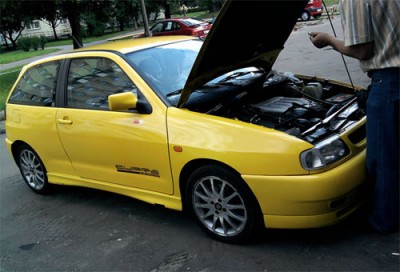
Marcin Królak
Opinion of the day. 12.07.2011
Mitsubishi Lancer Sedan 1.6 MIVEC gasoline
Year of Build: 2012
Engine size: 1,600
Mileage: 18 000 km
Although I used Ceramizer of this company for the fourth time, I decided to share my opinion for the first time. The reason was that last time I had a big problem finding opinions about the use of Ceramizer in a practically new car. Previously, I used the preparation in two Fiats: Albei 1.2 from 2003 and Punto FL 1.2 from 2005. Now I decided to add the agent to the Japanese Mitsubishi Lancer 1.6 from 2012 at the first oil change (Ceramizers for the engine and fuel at the first warranty inspection). Before buying, I combed the Internet for reviews about the use of the agent immediately after the car arrived (I did not find it) and contacted the customer service info@ceramizer.pl. Here I received an assurance that the use of the agent is completely safe. For lancer I used a means for the course of… 10 thousand. Miles. I didn’t take any pressure measurements because it didn’t make any sense at all. What did I notice? The fastest mute work. Already after 100, 200 kilometers the car in the feeling became very quiet. The work of the engine became velvety and even more even. At idle speed, the car is practically not heard. At first, I had to check if it had accidentally gone out by looking at the tachometer. Another symptom is… increase in fuel consumption in the initial period of ceramization. Fortunately, it stopped at about 2,000 km after using the agent and gradually decreased after passing thousands more. Now, after more than 8,000 km since the beginning of ceramization, my Mitsubishi burns on average almost a liter of gasoline less. I did not have many opportunities to check the performance of the car, but on the neighboring highway I calmly managed to accelerate the car to over 200 km / h (previously just over 180 km / h). I did not measure the acceleration, but in the feeling the car is more agile and more flexible. To sum up – I can confirm that using Ceramizer in the car immediately after arrival is safe and economically profitable. I plan to use the agent already every second review, hoping for a cheaper and trouble-free driving of this car for many years to come.
Piotr Kubiak
Opinion sent on 2013-09-01
Radek
Ceramizer for the engine I used in the car Toyota Avensis T22 from 2001 with the engine 1AZ-FSE (gasoline 2.0 150 hp) with a mileage of 140 thousand. Miles.
The reason was a decrease in the performance of the car, the reason for which, as it later turned out, was a significant decrease in compression in the cylinders. I ride very dynamically and I race a lot, so the state of affairs did not surprise me, but it was very worried.
The mechanic, who usually deals with my car, stated that in this case it remains either renovation (very expensive) or changing the oil to a denser one (which in this case is unfortunately only a half-measure and was not an option).
I had read about various “additions” before, but I was very skeptical about them. However, I thought that the expense is small and probably worth a try. The measurement before (and after) the use of Ceramizer was made at the Toyota ASO in Olsztyn where I service the car. The result visible on the left chart turned out to be not very optimistic. The level of compression pressure seems to be normal, but unfortunately at the lower limit, which for this engine is 10 bar.
I applied Ceramizer according to the instructions and after driving about 4 thousand. km I went for another measurement. To my surprise, there has been a significant improvement!
You can see on the right graph (measurement made in reverse order of cylinders) that the compression pressure increased on each cylinder by approx. 1 bar or about 10%. In my opinion, this is a very good result. I consider the money spent on Ceramizer to be well invested and with a clear conscience I can recommend this preparation to everyone.
Radek
Tomasz
I approached the matter like everyone probably with a slight disbelief, but the description in the auction and the very comprehensive material I read prompted me to test ceramizers, I have two cars radically different from each other namely: Citroen Xantia 1.8 16V Hatchback and Honda Civic 1.5 16V Sedan with similar mileage 120-140 thousand. Kilometers. I was not looking for a means to improve compression due to the fact that both engines are in very good condition at such mileage, although Honda is definitely better in this matter than the French competitor 🙂
Xantia from 96r with a mileage of 143k consumed an average of 10.5 liters / 100km with normal urban driving, Honda from 90r. with mileage (actual) 122thousand. consumed in the same conditions 7.5 liters / 100km, as if not surprising for people sitting in the subject of motorization, the Japanese usually smokes less but in addition to the savings on fuel consumption that I obtained after using ceramizer for the engine and once for fuel here: Honda – from 7.5 liters fell to 6.6 liters per 100km Xantia – from 10.5 liters fell to 9 liters per 100km !!! both cars significantly quieted down and became more dynamic and completely stopped the delicate oil picking (about 0.4 liters / 1000km) in Citroen in which it was accepted as the norm even in The Citroen ASO it did not surprise anyone (I was irritated quite sharply). Honda does not “take” a single gram of oil from replacement to replacement from the very beginning as I have it … To sum up: I am extremely satisfied and fully satisfied with the purchase and effects of ceramizers, I generally recommend to every friend without a shadow of doubt or fear that there will be disappointments or shame … Unfortunately, I do not have time for thorough tests or measurements, with my mode of work and daily race, the only thing I have to count on and know that it must always be 100% OK is the engine of my car, … and to be honest I do not remember when I had any failure or problem with the winter firing of the car even at minus 20 degree frost. Anyway, with a clear conscience I can say that I have already won anyway – I won the comfort and cheaper operation of cars thanks to ceramizers … for me it’s a SUCCESS! Greetings and good luck.. Tomasz.
Opel Zafira 1.6
Year of Build: 2002
Engine capacity: 1.6, 197 838 km mileage, power supply – petrol/LPG
Before pouring the ceramizer, the oil was changed along with the oil filter, the engine runs on Texaco 5W/40 synthetic oil
At the time of pouring the ceramizer, that is, at the odometer state of 196284 km, the engine works correctly in a mechanical sense. Combustion in the urban cycle is about 12 l / 100km LPG
Compression pressure respectively cylinders from 1-4: 14.5; 13,5; 14,0; 14,5
The engine operating culture is correct, with a palpable tendency to knock on the hydraulic valve clearance cancelers during engine idling.
Oil consumption about 1 liter per 1000 km
After the application of ceramizer and the course of 197838, the control examination showed:
– increase and equalization of compression pressure on individual cylinders 1-4 respectively: 15.5; 15,5; 15,5; 15,5
– silencing the work of hydraulic valve clearance cancelers at idle
– a slight increase in flexibility and efficiency of the engine, i.e. an improvement in the course of the torque curve
– reduction of oil consumption to 0.5 liters per 1000km
– reduction of fuel consumption in the urban cycle to about 10.5 L / 100km LPG taking into account temperature differences.
General sensations after applying ceramizer:
the engine works more “smoothly” with a noticeable improvement in terms of working culture and flexibility, the engine works as if it were quieter practically sitting in the cabin you can not hear the engine idling, the pressure equalization affected the very even operation of the engine. I would like to mention that in the winter the engine is always started hot via the parking heater that is installed in the car. I am very satisfied with the preparation used, which was made available by Ceramizer Sp.Zo.o. to carry out the test, I did not expect such an effect as I received, in particular the increase and equalization of pressure in the cylinders.
Gregory Potempa
Removal of the board before pouring Ceramizer odometer value 196284 km.
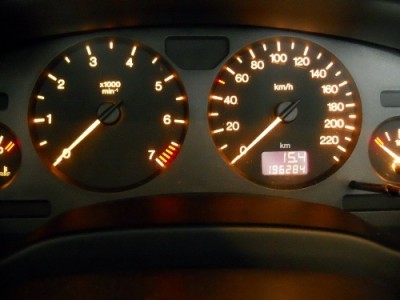
Photo of wires from pressure measurements:
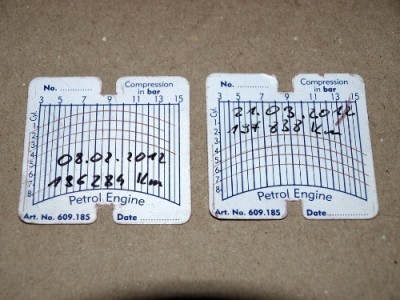
Photo of the board after 1554 km with Cermizer 197838 odometer:
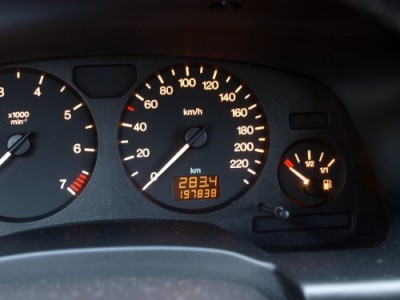
Jacek Gorka
I bought ceramizers. The first time I bought the one for the engine. I applied. Then in a short time I bought a whole set of 3 pcs. because I also wanted to apply to the gearbox and the one that cleans the injections. It was on sale so I bought the whole thing. I admit that using this one for the engine I did not measure the compression before, but it did not matter to me because I knew what I was doing when buying the preparation. The opinions of the users who used it spoke for themselves, so I tell myself I’m going all the way. I measured the compression after applying and driving according to the instructions for the required kilometers.
My colleague – mechanic Robert Stępień Garage 42-530 Dąbrowa Górnicza ul. Majewski 202 could not believe, although he was familiar with such means. The compression on each cylinder was almost equally 13 and in the catalog 13.2 so we were delighted with the performance that the preparation gave in my Toyota Corolla vintage 1993 Liftback 16V 1.6 114HP, which has already driven 310,000, well then it was below 300,000. I myself noticed that the engine works differently quieter, evener and better “collects”, more dynamically, has a greater moment. I was and I am satisfied I will definitely recommend the preparation. To tell the truth, I recommended it to my friends and they are happy. I did the same with the gearbox by pouring the preparation. The gearbox “immediately” began to work better, I was delighted, the gears entered lightly and more accurately. This is still the case today. I immediately poured the preparation into the fuel tank. Well, here I did not notice changes, but I understand that cleaning injections, which apparently were not clogged, will not give noticeable effects.
Summing up and answering the question whether ceramizers are effective, I will answer as a car user who used them that YES, they really give results and I am satisfied. For little money, I improved the performance of my car. In the near future I will buy preparations again! I cordially greet and wish you success in the development and sale of preparations. Jacek Gorka
BMW 530 D
In the BMW 530D Car Reg. No AA-VM 746 I decided to use Ceramizer – it was used for fuel. In the engine there was a problem of one injector, the replacement of which is associated with a cost of about 500 euros. After filling half of the tank with fuel with Ceramizer (fuel refiner), any irregularities in the work of the injectors disappeared. Before using Ceramizer for engine oil, a car with a mileage of 270,000 km was checked on a dynamometer and power and torque data were collected, etc. After applying the ceramizer and driving 4,000 km (exactly 3782km), the car was again checked on the dynamometer. An increase in power and torque was found. I personally found a reduction in fuel consumption by an average of about 1 liter per 100km and quieter engine operation, greater flexibility. Warsaw 14.10.2008
Andrew Hoffman
Warsaw

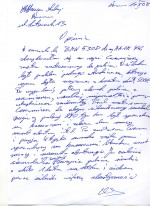

Mercedes 300 (1990)
How I saved 2000 zł using ceramizer for engine oil.
When buying ceramizer I approached this product very skeptically, within 1/2 year I used 4 doses. My Mercedes 300 engine is 90 years old, it has driven over 1 million kilometers. I was getting ready for a thorough overhaul of the engine and of course I held fast by the pocket (about 5000 zł.). When I managed to accumulate such a sum with a soul on my shoulder, I went to the workshop. Because 2 years ago I changed the gaskets under the head, I knew that in the cylinders I have quite large faults in the upper part. Now a thorough renovation was being prepared. The cost of the cylinders themselves and there are 6 of them is 300 PLN x 6 = 1800 PLN. What was my surprise when I saw after removing the head that my large faults (from 2 years ago) were perfectly filled with metal. It differed from the rest of the cylinder smoother only in a darker color. The cylinder smoothness was in perfect condition. I didn’t believe it. I only ended up replacing the piston rings (2 cracked). Now, after the renovation, I also pour ceramizer. I would like to point out that earlier I had a huge consumption of engine oil, which in my opinion was not conducive to ceramizing (despite this, the effect exceeded my expectations).
Highly recommended
Pawel Tonborek
10.08.2007
MAN NG 272 (articulated city shuttle bus)
Ceramizer was used in two MAN NG 272 buses for engines in which the oil pressure dropped to 0.2 – 0.3 atm, there were exhaust gas blows to the crankcase, the engines “took oil”
Buses are equipped with engines:
1) with a displacement of 6871cm³, power 184 KW, mileage 803 500 km, capacity. oil sump 25 l,
2) with a displacement of 6871cm³, power 198 KW, mileage 832 450 km, capacity. oil sump 25 l.
Buses adapted to carry a total of 159 people (51 seats and 108 standing). They are equipped with automatic transmissions. Throughout the period operated in public transport with high traffic, in the field with significant climbs up hills under full load. After applying the agent in the amount of 6 containers for each engine, the engines were first silenced, then slowly along with the mileage after about 1500 km the oil pressure increased and remained at the level of 2.5 atm. The engines stopped burning excessively oil, there were no blow-offs in the crankcase. Fuel consumption has also decreased by about 1.5 l / 100km, which confirms the opinions of drivers as if the engines gained more power. Engines, especially in winter, are easier to start.
Both buses have yet passed without the need for engine repairs of about 100,000. Kilometers. I confirm the suitability of the agent to save a worn engine and extend its service life without the need for expensive renovation.
Przedsiębiorstwo Komunikacji Samochodowej w Rybniku Sp. z o.o.
Siwica Jerzy
Mercedes 190 E 2.3
Engine: 2.3 petrol + LPG
I am the owner of a Mercedes 190 E with a capacity. 2.3 petrol + LPG. I used a set of ceramizers 5 pcs. REVELATION! After driving 1,500 km I noticed:
1. quieter engine,
2. less fuel consumption by 1/3,
3. each firing even at low temperatures,
4. the gearbox does not grind, the gears enter lighter,
5. rear bridge silent.
The pressure in the 4 cylinders increased as on the attachments. I am very satisfied with the purchase and use of ceramizers. I really highly recommend it to all users of old cars.
Andrew R.
Andrew Karpinski
Unfortunately, I do not have any written evidence, so I have to rely on my subjective impressions of the driver and the owner of the car, well, but in the end I bought ceramizers not for research purposes, but to improve the performance of my car. And these and yes, have improved significantly, thanks to which I saved not only money on fuel but – most importantly for me – a lot of nerves during the just past, hard and cold winter.
The car I drive is an old, produced in 1987 Volkswagen Passat with a diesel engine with a capacity of 1600 ccm. I am not able to determine the true mileage of this vehicle, besides, I bought it knowing that the engine was replaced and the odometer showed about 220,000 kilometers … which seemed suspiciously little to me anyway. The car was operational, but after a few months I noticed intense smoke from the exhaust pipe, blows through the smoke on the air filter, lack of power, and finally – engine oil consumption exceeding all standards. In other words: the engine was “starting to run out”… I could not afford to renovate, I could not afford to buy another engine as well, I do not trust all sorts of “doctors” thickening oil, so in total I have already come to terms with the idea that there are about nine months left until the “technical death” of the car, a year with good treatment … I was not happy about it, I bought this car with the idea that it would serve faithfully as a capacious and economical workhorse for at least three years.
Because from time to time I make purchases or sell something with the help of Allegro on ceramizery I got there. I read the description and opinions of users, I laughed a little about driving a Polonaise without oil because I am skeptical by nature and I have a problem with believing in miracles, I calculated that my car would need at least 2 packages of ceramizer which means a cost exceeding PLN 100. For others it’s probably small, for me it’s not…. I gave up. A few days later I talked about ceramizers with a colleague who has the same car, you know, car drivers, especially those driving the same model, have something to talk about. The content of the conversation I forgive myself, one thing is important – a friend of ceramizery applied and praised terribly. I returned to the topic, I felt sorry for this stówki cruelly but the promised benefits were tempting, I clicked “buy now”. I studied the instructions for use several times, gave ceramizer to the engine and according to the recommendations I used the car as if I was driving Mrs. Daisy …
The improvement did not appear suddenly, I will be honest, after two weeks I doubted whether it would appear at all. Grief for the lost stówka was growing. Somewhere after a month and a half I went to visit a family living at a considerable distance, I think: the work of the engine and the increase in power are impressions that are difficult to measure. Maybe it’s actually easier to spin, maybe less smoke, even some cars I can overtake…. but all this cannot be measured, or at least I do not have the right desires. But – measuring combustion is not such a philosophy again. I flooded the car to full and set off on a 500-kilometer route. And then, refueling the car on the way back, I stopped regretting the money spent. It is known that depending on the driving style, the car burns differently, but I knew one thing about mine: on this route it always took 32 – 35 liters of diesel fuel. This time, 26 liters of !!! You can’t fool yourself so much, even driving 90 per hour on the entire route!! So ceramizer works!! Later it was only better. The smoke from the pipe has disappeared, the air filter that was constantly changed before is now dry, the blows visible after opening the oil filler cap have disappeared. I am talking about verifiable facts. My impression that the car starts better, walks more evenly, has gained power and is definitely quieter is just an impression, it is impossible to check and no one has to believe me. But the facts remain facts – I added less and less oil to the engine, now I do not have to add anymore, the cost of traveling 100 kilometers has fallen, the investment in ceramizer has paid off and brings profits …
And then there was this last winter – I wanted to laugh, and maliciously. Like some of my newly-rich neighbors in glittering wickets laughed at my old Passat… At minus 25 degrees at 6.00 in the morning I got into my VW, heated the candles twice and fired the car. My neighbors fired up their cell phones and called the radiotaxi with cables :-))) Maybe it’s not nice that I’m a little mean, but I don’t know a real driver who wouldn’t be oversensitive about his car. I like my Passat very much and I’m terribly happy that I was able to postpone its end… I’m not saying that ceramizer painted over the traces of rust on the fenders, repaired the rear wiper and glued the lampshade from the lamp – this is not a “gray ointment” for any car malfunctions. But I know for sure that the engine is still moving only thanks to the ceramizer, I did not use anything else. So much for my impressions of using ceramizer… I do not want to convince anyone, the expense, as I wrote for me, at least was considerable. But it paid off, and that’s the point.
Andrew Karpinski
Fiat Cinquecento 0.9
In my cinquecento I had a power loss problem probably caused by a slightly obliterated engine. The failure of the radiator fan caused me to boil the coolant, which also had a negative impact on the combustion chamber itself. I seriously considered a general overhaul, but while browsing the Internet forums I came across a description of the Ceramizer’s operation for the engine. At first, I was skeptical- “How can pouring liquid replace the renovation?”. I read a lot of reviews about ceramizers on the Internet and decided to try it (after all, the cost of renovation is many times higher than ceramizer).
Since the opinions of other users posted on websites helped me in making this decision, I also decided to document my experience after using ceramizer for others. Before adding the ceramizer to the engine, the pressure measured on individual cylinders was as follows:
I – 7 bar; II- 9,5bar; III- 7.7bar; IV- 8.8bar. Ceramizer was poured immediately after the measurement, on April 19, 2008 at a mileage of 123627km. Driving at a reduced speed did not cause any major problems, I ride mostly on short sections in the city so covering 200km at a slow pace was not particularly burdensome. The first observations concerned quieter and more even operation of the engine, the car was much more pleasant to drive than before. Initially, I did not observe an improvement in power, but this is probably because it increased gradually as the ceramizer worked. When I decided to check the maximum speed on the route I was covering, I was very pleasantly surprised. The car previously barely exceeded the 120km/h hand. After about 1000km after pouring ceramizer I could go about 135km / h. Apparently only 15 km / h difference but very noticeable with such a small car.
The final test using the compression pressure measurement was performed on May 22, 2008, with the odometer status of 125349km, i.e. 1722km after pouring the ceramizer. The results of the measurement confirmed what I could feel earlier – ceramizer works!!!.
The pressure in the individual cylinders landed as follows: I – 10bar; II- 10,5bar; III- 10bar; IV- 9.8bar.
The pressure on each cylinder increased at least 1bar (10%!) and leveled out, which, as I wrote earlier, was felt in better engine operation and performance. An additional benefit that I noted after using the ceramizer was a reduction in fuel consumption. On average, the car burns 0.5 liters of gas less per 100km, which with my ride means that the cost of buying only through savings on gas will pay off after 5,000 km, i.e. after 3 months. Not counting, of course, that I did not have to spend a lot of money on an expensive renovation.
To sum up, I encourage everyone who has a similar problem with their car to use ceramizer, they will certainly not regret it. You can only gain!!! Luke
Audi 80 B3 (1988)
After reading many flattering opinions about your products on the Internet and due to some shortcomings of the 1.8 engine in my Audi 80 b3 from 1988, I decided to convince myself of the operation of the offered ceramizer for the engine. After receiving the parcel, I just had a great opportunity – a 260km route from Bydgoszcz to Warsaw. Following the recommendations, I applied the contents of the tube to the heated engine and after 10 minutes at idle I set off on the road, to tell the truth without exorbitant hopes. And in fact, I didn’t feel any change…. until the way back. It was very positive that my surprise that the engine caught fire after a shorter start and walked much quieter, but the joy reached its zenith when for the first time after a year of owning this Audi I easily overtook in V gear! What’s more, even one “chirping” valve tappet in the head was silenced, so I was extremely happy that the cost of replacing it had gone. Unfortunately, I do not have a graph from the diagnostic station, but when buying a car on my own, I made a compression pressure test, it ranged between 9.5 – 12 bar (mileage 270,000km). After applying ceramizer I retested and the difference decreased to 10.5 – 12 bar!! The engine runs evener, it is easier to spin on the revs, there is a noticeable improvement in dynamics and combustion in city mode has dropped from 10.5-11 l / 100km to 9-9.5 l / 100km (gasoline) ! I will point out that I ordered 4 packages of ceramizer, also for the car of Father and two colleagues. In their case, analogous results were noted. In Father’s car, it was supposed to be rather a cosmetic procedure, because his Opel Astra 1.6 from 1998 had only 70,000km of mileage and walked flawlessly, but even in this case the increase in dynamics was at least noticeable. We are all fully satisfied with the use of the product and can confirm that ceramizers really work. At such an affordable price, receiving such a wide spectrum of benefits is simply a hit. I used the preparation in November 2005. The biggest difference I noticed after driving the first 260km, in the next kilometers there was a normalization of the engine operation. At the moment, since the use of the ceramizer, I have driven approximately 10,000km, the improved engine parameters still persist, there has been no engine malfunction, everything is clockworking.
With full responsibility, I recommend the ceramizer I used for the engine and I declare that the opinions contained here are my own and completely true observations.
Yours sincerely,
Radoslaw Jakubowski
Skoda Fabia 1.9 SDI
year of prod. 2003
mileage 269000
The car drove in my company and as such was quite heavily exploited, as I bought it back it was already heard characteristic of diesel “patting” and loss of power which with a mileage of about 260,000 was not so strange. The characteristic metallic reverberation and “shaking” of the steering wheel was also a problem. At first I thought about renovating the engine, but after various consultations I was visited from it, as it took maybe not much oil and nowhere liquid.
I was looking for another method to increase the compression and came across your product, which I approached a little skeptically, although encouraged by the graphs from the dynamometer.
But to the point, I poured only one dose at the beginning, and it looked like this: Warsaw-Nidzica route, I warmed up the engine.
At the gas station outside Warsaw I poured a dose into the oil, after about five minutes you could hear the engine getting quieter, and it was not my subjective feeling after the passengers noticed the same thing, later the route to Nidzica, I kept the revolutions to 2500 but you could already hear that inside it is quieter and you did not have to “abuse” your voice to talk, it was felt that the engine pulls from 1500 revolutions and not as before from 2000, the steering wheel stopped shaking which I admit earlier terribly irritated me, and this characteristic metallic reverberation became soft, not metallic. Now, after driving about 10,000 km, I can safely say that the combustion has dropped by about 0.5 L and with my as much as the car allows, dynamic driving is a lot.
As soon as I do a big review and replace the timing belt, it will definitely flood the next dose.
And I did not mention the start-up, to be honest the battery is suitable for replacement and when the compression came back to feel that the battery is replaceable, but as it turns it again you can hear a beautiful kick from the first touch.
David Czaja
Warsaw 3.04.2008r.
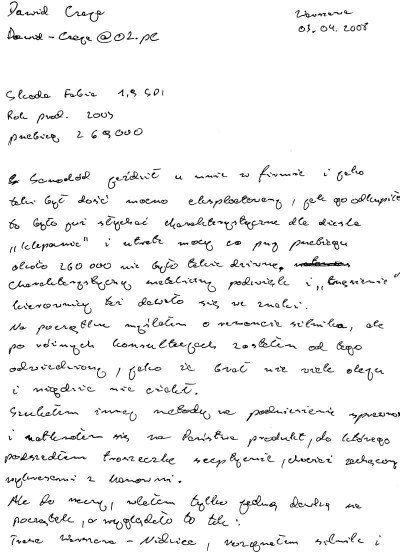
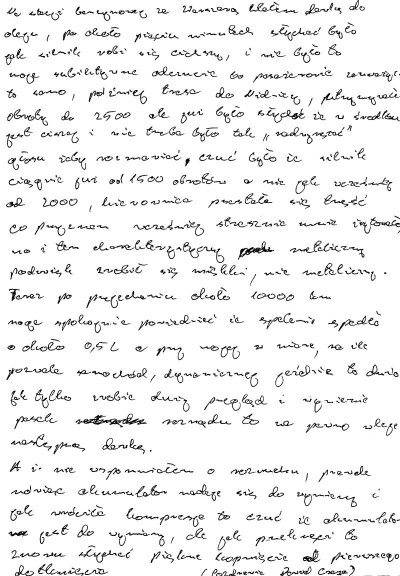
Chevrolet Corvette 5.7
Year of Build: 1999
Mileage: 165 000 km
I BOUGHT A CORVETTE WITH A MANUAL TRANSMISSION. I HAD A RATHER SERIOUS PROBLEM WITH THIS GEARBOX, NAMELY 1 GEAR WITH PROBLEMS ENTERED (SOMETIMES HE LIKED TO JUMP OUT) AND I HAD TO PUT THE TWO SEVERAL TIMES. I BOUGHT A CERAMIZER FOR THE TRANSMISSION (so a little not entirely convinced whether it will help) and after 100-120 kilometers driven from pouring ceramizer into the box THE WORK OF THIS BOX IS INCOMPARABLY BETTER!-the gears enter much better and the work of the box itself is quieter.
Robert Mikolajczyk
Opinion sent on 4.5.2011.
Chrysler Voyager 5 TD VM
Year of Build: 1994
Engine size: 2.5L
Mileage: 310 000 km
In general, I am pessimistic, especially when it comes to revitalizing inventions such as VM engines. After much deliberation, I made a decision. I am a chemist by profession and I am skeptical about all kinds of “miraculous means”. In a telegraphic summary, my feelings. I don’t have data on compression ratio graphs, but I know how the gas pedal works for me and the gearbox goes. Generally, the car is often used on short routes. But to the point: Ceramizer for the engine. After 300 km, the volume of work and such a loud VM is reduced. After 500 km, the sound of the engine becomes softer (less whining, VM experts will know what is going on) After 600 km I noticed that the smoke (it was small for me), after all, it has decreased (the exhaust pipe for me goes to the side, hence I know that when it smokes and when it does not. Just look in the side mirror). Fuel consumption is at a similar level, because the car is used for short distances in difficult urban conditions, so it is difficult to find a comparative scale. Its briskness and reaction to pressing the gas pedal have noticeably increased. Ceramizer for gearbox. This model, and more precisely its gearbox, has the opinion of a disposable, because aluminum, pasted bearings, etc. For her age, it works, but she was buzzing. The gears went in and out smoothly. The essence is that after about 200 – 300 km the humming stopped. Maybe a little more precisely enters the reverse. Summary. Who knows what are the prices of repairs of VM engines (I refer to Google), he will know that such a “vitamin” as Ceramizer is certainly not a throwaway money (this is the equivalent of a donation to the tray). The gearbox works like a 5-year-old, not like an 18-year-old. In a word, from now on, I will add Ceramizer to every oil change. I emphasize, I was a pessimist, but “my grandfather Voyager” convinced me. Best regards!
Peter
PS. Oh, and one more thing. It is true that I have not done these attempts before (by the way), but on the highway it pulled 185 km / h (GPS 174 km / h), causing a rather peculiar view and comments on CB-Radio. Comments are one thing, but new, powerful cars were escaping from the left lane. Taking into account the age of the car, it aroused symptoms of surprise in the sold out With the rest I am not surprised, two tons of steel, which should already be scrap (although due to age) in such a condition (?)! I’m not 100% sure, but I have the impression that it’s also due to Ceramizer in the engine. Width!
Opinion sent on 3/31/2012
Ford Mondeo 1.8
I would like to share the results of measurements made in the car Ford Mondeo 1.8 gasoline 16V, mileage before applying the preparation 151440 km, (it is difficult to say whether this is the original mileage). After passing the recommended approx. 1500 km at 153030 km the results of measurements on the same instrument were:
| Meter status | Distance from application time | Cyl 1 | Cyl 2 | Cyl 3 | Cyl 4 |
| 151440 km | 0 km | 11 bar | 7 bar | 10 bar | 11.5 bar |
| 153030 km | 1590 km | 14.1 bar | 15.3 bar | 14.6 bar | 14.5 bar |
For me this is a revelation, Ceramizer not only raised the compression pressure on all cylinders, but on the second cylinder it raised by more than 100%. A mechanic friend who did this couldn’t believe it. It seems to me that such compression pressures have nominal engines. The results of measurements after 1590 km from the application of the preparation are presented in the photo:
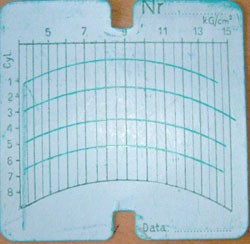
Best regards
Miroslaw Andrzejak
72-001 Kołbaskowo 91/4
Date of receipt of the opinion – 04.05.2005
Further feedback: After pouring the agent on the first ride, you could hear the quieter operation of the engine. After driving the first time approx. 130 km at a standstill the engine was audible almost like a fan, it really worked very quietly and evenly. I thought then that there must be something in it and I was looking forward to the final measurement after these 1500 km. Later, with the passage of kilometers, it seemed to me as if the car was more agile while driving, and I think it remained so. And I am most pleased with the fact that the preparation compensated me for this weak compression pressure on the 2nd cylinder.
Regards, satisfied, Mirosław Andrzejak
Date of receipt of the opinion – 11.05.2005
VW Passat
Year of Build: 1999
Mileage: 220 000 km
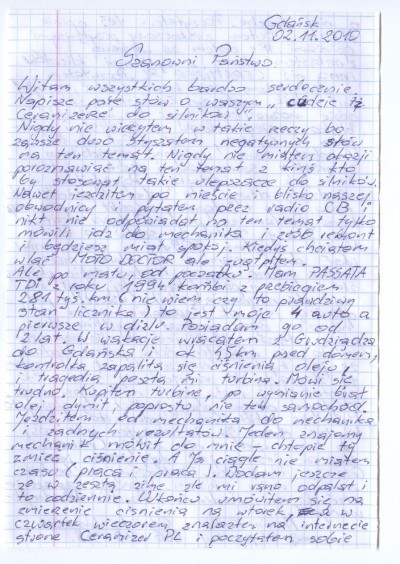
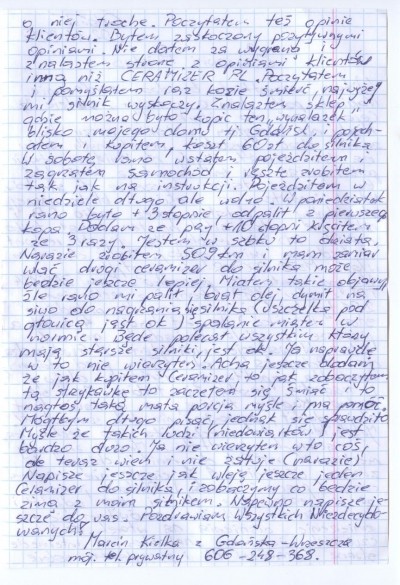
I will write a few words about your “miracle”, i.e. Ceramizers for engines. I’ve never believed in such things, because I’ve always heard a lot of negative words about it. I’ve never had a chance to talk to anyone about it who would use such engine enhancers. I even drove around the city and close to our ring road and asked on CB radio and no one answered me about it, they just said “Go to the mechanic and do the renovation and you will have peace of mind”. Once I wanted to pour Moto Doctor but I doubted. But slowly, from the beginning. I have a Passat TDI from 1994 station wagon with a mileage of 281 thousand. km (I do not know if this is the real odometer). This is my 4th car, and the first in the dizl. I have had it for 2 years. During the holidays I was returning from Grudziądz to Gdańsk and approx. 45 km in front of the house, the oil pressure indicator light came on and tragedy: the turbine went to me. It’s hard to say.
I bought a turbine, after replacing it took oil, smoked, just not this car. I drove from mechanic to mechanic and no results. One mechanic friend would say to me, “Boy, you measure the pressure!” and I still didn’t have time (work and work). I will add that last winter it fired badly in the morning and every day. Finally, I made an appointment to measure the pressure on Tuesday, and on Thursday evening I found the Ceramizer.pl website on the Internet and read a little about it. I also read customer reviews. I was surprised by the positive feedback. I did not give up and found a customer review site other than Ceramizer.pl. I read and thought “once goat death”, at most my engine will pop up. I found a shop where you could buy this “invention” near my home, i.e. Gdansk and I went and bought, the cost of 60 zł for the engine. On Saturday morning I got up, drove and warmed up the car and did the rest as in the manual. I rode on Sunday for a long time, but slowly. On Monday morning it was +3 degrees, he fired from the first kick. I will add that at +10 degrees I shot with 3 times. I’m shocked, it works. For now, I have done 509 km and I am going to pour a second ceramizer into the engine, maybe it will be even better. I had such symptoms: I smoked badly in the morning, took oil, smoked gray until the engine warmed up (the gasket under the head is ok), I had combustion in the norm. I will recommend to everyone who has older engines, it is ok. I really didn’t believe it. Oh, I will add that when I bought Ceramizer, when I saw this syringe, I started laughing and it was out loud. Such a small portion I think and is to help. I could have written for a long time, but it worked. I think that there are a lot of such people (doubters). I didn’t believe in it, but now I know and I don’t regret it (for now). I’ll write more when I pour one more Ceramizer into the engine and see what will happen with my engine in the winter. I will definitely write to you. I greet all the Undecided.
Marcin Kielka from Gdańsk
Opinion sent on 9.11.2010.
Honda Concerto 1.5 (1992)
I have a Honda Concerto 1992 year, 214 thousand km of mileage, with a d15b2 1.5 engine. I was looking for a car for a long time, initially it was supposed to be a 4th generation Civic due to very good performance (low weight of the car), but after a few viewed copies, emotionally I was exhausted. The cars I saw were simply in very poor condition, whether it was a bodywork (after many craft repairs) or mechanical (the gas was not seen by the fact that I did not see the car from white smoke). Looking out for the civic, I jumped to the section -> concerto. After a few conversations and analysis of the car on the web, I decided to go to see -> the same day I bought. The car was and is really neat. Due to the fact that I am interested in practical motorization not from today, I do not hate how something in my car does not work. A very frustrating glitch was the wiping of the synchronizer of the 2nd gear. To hammer twoS I had to do it very slowly, with a turnover below 3.5 thousand. It was very annoying especially at the time of overtaking, fast gear changes and chrrzzzzz … I decided to use ceramizer, I know a lot about the preparation, so I tried. I drove into the canal, somehow got into the gearbox plug. due to the difficulty of access to the oil filler to the box, I added the preparation to the inner part of the cork, after all, the working oil, spreads from the gears throughout the box. I turned off the traffic jam and left the garage thinking about how such a 5 ml can work in total, the so-called rational mode of thinking turned on me. With the passage of kilometers I noticed that the gear ceases to grind me, I approached the gear change more and more courageously, until after about 500 km I pushed the car into the section on the 1st gear and drove the two as fast as I could. I felt a little abnormal, the run did not want to grind. In Hondas of these years, the characteristic is the difficulty in driving the initial gear, not important whether it is civic, prelude or concerto. It remained unchanged, I do not know what this fault is, because it does not bother me especially, after wsyprzegleniu is ok. The engine took me about 0.4 liters of oil per 1000 km . After applying the preparation, the consumption dropped to about 0.2 l / 1000, after changing the oil to the same but new (that one became rare, it was not replaced by the intermediate owner), oil consumption fell to practically ZERO! On the bayonet after more than 1 thousand km and quite dynamic driving is the same. I did not make comparisons as to the dynamics, the car is gassed and although the regulation itself and the quality of the gas itself changes the dynamics of driving, and the gas is regulated from time to time. Apparently, as for the Concerto it is fast, although this model with 1.5 on two points does not belong to the speed demons.
Arthur K.
Honda CRX 1.6 (1992)
I am a user of Honda CRX III 1.6 16V 92r.125KM about Ceramizerach I learned from a friend and of course at the very beginning I did not believe in what my friend says how great they are. My curiosity about them, however, took over and I bought 2 Ceramizers for the engine and one for the gearbox. The car has a mileage of 180,000 km, although in fact it probably has more I think that with 300,000 km due to the appetite for oil and here 1 liter per 1000-1500km depending on the driving style. After a conversation and many of my questions (with Ceramizer) how to use this Ceramizer in an engine with such a large mileage, I started to TEST. The first dose to the engine – the car worked an hour at slow speed later I did 200km calmly then I drove another 300km and applied another dose and here the same little worked motor at slow speed and another 200km without exceeding the rotational speed of 3 thousand rpm. I forgot to add that the pressure on the cylinders was within 9.1 Atm and after the test increased between 0.3-0.5 Atm unfortunately I do not have photos because the mechanic had what he called a clock instrument or something and was able to give me only a reading from the clock. In any case, the assumptions of the CERAMIZER company that the pressure will improve have been confirmed, and so it happened. The next attempt was to press the gas pedal to the so-called “breath” and what turned out the car stopped mounds earlier it looked as if someone fired the old SYRENKE behind the car was white.”we go further” – the engine already after the first dose began to work quieter ceased uneven engine vibrations. after 2 doses and already after driving 200km you could drive normally and check what the combustion will be, so it fell by about a liter along the route, i.e. from 6 to 5 l, and here to my surprise I went below the combustion that the car manufacturer in the city gives from 9.5 to 8-8.5 l / 100km. Now a few words about CERAMIZER to the gearbox, or the gearbox in August I can not say because it walked quietly as it is in the Japanese, while when it comes to changing gears after driving about 100km even until it shocked how lightly the gears change. Changing gears has become a pleasure to walk very softly as if they were changed hydraulically. At high revs from the change from 1 to 2 and from 2 to 3 gear synchronizers often did not work out and ended with the grind of wheels zebatych not a nice feeling … Now you can turn the boxes as soon as you want and since the use of CERAMIZER such cases have not happened to me anymore gears at 7000 rpm enter as in a new car without any resistance grinds, etc. It remains for me only to say that I am VERY satisfied with the use of CERAMIZER in my car because the benefits that it brought me are much more worth than the cost of its car from applying CERAMIZEROW has already done 10 thousand km car with the above-mentioned one liter of oil for 1000-1500km for these inches 10 thousand wzielo already only 2l (I also note that I have replaced valve sealants and the car is exploited at quite high speeds and if not for it probably instead of adding oil would end only on its replacement but you know the high speed is and the car something lyknie)ps: driving on oil AGIP 10W60 cost 1 L is 40 zł also with these 10thousand cost CERAMIZERA already returned to me 🙂
Paul Pilate
Opinion sent on 04.04.2008
Jeep Cherokee 2.8 CRD
Year of Build: 2004
Engine size: 2800
Mileage: 115 thousand km
Preparing the car for holiday trips in the Carpathians, I undertook multidirectional actions to increase safety and technical efficiency. In addition to the production and assembly of aluminum plates protecting the chassis components (engine, gearbox, fuel tank), I also replaced all oils and filters.
I also considered it justified that, due to the possibility of moving the vehicle at high tilts and the resulting real deterioration in lubrication efficiency, a preparation should be used to reduce the coefficient of friction between the engine and transmission components. In the message I used MILITEC and .. did not hurt (this feature is very important, and does not always occur in relation to many of the preparations available on the market – there are widely known cases of “clogging” lubrication / cooling channels by preparations containing solid particles) I decided to look for something new and … Proven.
During conversations with friends, a colleague from the technical school told me about how he “silenced” the pusher in the Mitsubishi V6 by adding CERAMIZER to the engine oil. Later there was an analysis of opinions on the net. Since the theoretical basis of the drug seemed to be right, I decided to check how it would behave in practice. The decision to buy and then things were going very quickly: purchase, application to hot oil and 4 hours at idle speed …
Unfortunately, no measurements of the engine operating parameters were made before application, so the measurement of anything after application is pointless – no reference point. As a car driver by profession and passion, however, I feel obliged to share with all interested people what I noticed:
– decrease in fuel consumption – it was about 15 l / 100 km; is about 12-13; of course, with the same conditions and driving style, always included 4×4 fuul time and air conditioning; I reckoned with the increase in fuel consumption due to the installation of a large expedition roof rack), subsequent refueling and calculations carried out on their basis confirmed the durability of the obtained effect, the decrease in fuel consumption is also indicated by the on-board computer
– engine silence – a clear difference, the engine works more flexibly and more “soft”
– very low engine oil consumption – the engine currently has 122 thousand km traveled; the oil level decreased approx. 3-4 mm (over a distance of 7,000 km, of which 3,000 in difficult mountain terrain – including driving with a reducer attached, 2,000 expressways and highways – speeds of about 110-140 km / h, the rest of the city and its surroundings with very short routes and thus frequent engine starts)
– “freer” starting and running the engine
As a result of the above experience, I decided to apply the preparation in my other cars (Honda HRV and Suzuki Vitara, and in the future – after the renovation – probably also GAZ 67B Czapajew; the use of CERAMIZER in this case should be mandatory due to the bucket lubrication of connecting rod shells).
Greeting – I invite everyone interested in the obtained effects to ask questions and exchange experiences
Ph.D. Piotr Lubinski
Tel. 790570500
Date of review: 11.08.2010
Man (public transport bus equipped with automatic transmission) diesel engine D0826 LUH 12 EURO 2
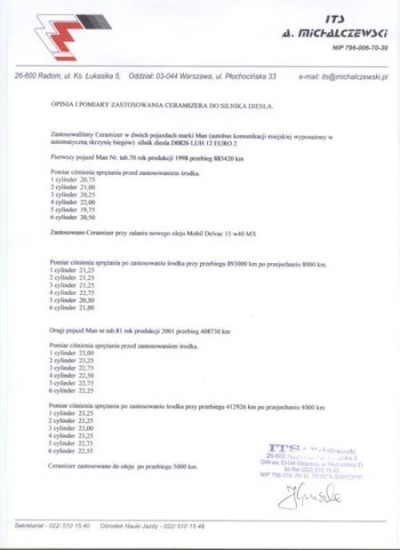
OPINION AND MEASUREMENTS OF THE USE OF CERAMIZER FOR DIESEL ENGINE.
We used Ceramizer in two Man vehicles (transport bus equipped with automatic transmission) diesel engine D0826 LUH 12 EURO 2
First vehicle Man Nr Tab.70 year of manufacture 1998 mileage 885420 km
Measurement of compression pressure before applying the agent.
1 cylinder – 20.75
2 cylinder – 21.00
3 cylinder – 20.25
4 cylinder – 22.00
5 cylinder – 19.75
6 cylinder – 20.50
Ceramizer used to pour new Mobil Delvac 15 w40 MX oil
Measurement of compression pressure after application of the agent at a mileage of 893 000 km after driving 8000 km.
1 cylinder – 21.25
2 cylinder – 21.25
3 cylinder – 21.25
4 cylinder – 22.75
5 cylinder – 20.50
6 cylinder – 21.00
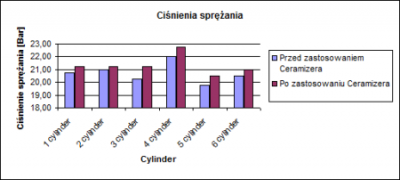
Second vehicle Man No. tab. 81 year of production 2001 mileage 408730 km
Measurement of compression pressure before applying the agent.
1 cylinder – 23.00
2 cylinder – 23.25
3 cylinder – 22.75
4 cylinder – 22.50
5 cylinder – 22.75
6 cylinder – 22.25
Measurement of compression pressure after application of the agent at 412926 km after 4000 km
1 cylinder – 23.25
2 cylinder – 23.25
3 cylinder – 23.00
4 cylinder – 23.25
5 cylinder – 22.75
6 cylinder – 22.55
Ceramizer applied to the oil after a mileage of 5000 km
ITS A. MICHALCZEWSKI
Opel Cadet
Production year: 1990
Engine: C2ONE 2.0 8v 115KM
Mileage: 201 647 km
Compression pressures before application of Ceramizers – date 11.02.2012, mileage – 199 331
Cylinder 1 – 12.2
Cylinder 2 – 11.4
Cylinder 3 – 11.2
Cylinder 4 – 11.1
Compression pressures after application of Ceramizers – date 17.03.2012, mileage – 201 647
Cylinder 1 – 12.7
Cylinder 2 – 12.4
Cylinder 3 – 12.5
Cylinder 4 – 11.6
Opinion of the vehicle owner:
Oil consumption: The mileage from the use of ceramizer is still too small but it was already noticeable that the car consumes less oil at the moment the consumption has decreased by about 30/40% but this may still change. Before the use of Ceramizer, oil consumption per 10,000 km was about 1.5 liters.
Engine noise: the car is already years old and does not belong to the quiet, you could feel the quieter operation of the engine I am very pleasantly surprised, I did not expect such an effect.
Starting the engine: there were no problems with starting, but on LPG you had to “spin” longer and now it burns to the touch it is a really noticeable change.
Fuel consumption: mainly the car works on LPG, the average combustion was approx. 11l/100 km according to calculations fell by about 1 liter, but as you know it can not be perfectly calculated so I can be wrong.
Vehicle dynamics: to feel that the car is more alive, it responds better to the gas pedal, but this is not a big change of the “it should accelerate better” type, but as I say it is noticeable, the difference can be felt in every gear, now it has potential.
Other observed changes: the engine at idle speed works evener than before the use of ceramizer, the oil pressure increased slightly. The oil is more viscous and sticky.
Transmission.
Noise: here I was very positively surprised, the sound of “howling” came out of the gearbox, especially in the 5th gear, it was cumbersome and unpleasant and very loud, this sound disappeared gradually but effectively and systematically until now when it is practically not heard and you can calmly take care of driving and not listen to the howling gearbox.
Ease of changing gears: gears enter much easier and smoother, I often had a problem with the one, especially when I had to stop and throw the one, e.g. at the traffic lights. This problem has decreased significantly, now it happens only occasionally (very rarely).
Grinding: the crunch mainly occurred in my car with a quick change from one to two, the reason for this was probably the synchronizer at the moment this phenomenon has decreased a lot and I could even say that it has disappeared completely. A slight crunch also occurred when changing the fourth gear to the fifth, but it was not frequent and strong now it does not occur at all.
Owner: Artur Pietrzyk
Opel Astra station wagon
Year of Build: 1995
Engine size: 1.6
Mileage: 265 000 km
Since 2009, the compression pressure on the 2nd cylinder has started to decrease steadily. I speculated that this might be due to the sealing of the piston rings. In addition, I found excessive oil consumption (about 1 liter / 1000 km at full load) and low compression ratio on the 2nd cylinder (8.00kg/ cm²; on the other 13.5-14.5 kg/cm²).
I was thinking about overhauling the engine, because fuel consumption was increasing and engine dynamics were decreasing. I had problems with the even operation of the engine, I often replaced the spark plugs and ignition cables. The mechanic advised me to use the Motodoktor oil additive, which thickens the oil. There were no revelations. It was only after applying this add-on that I began to search on the Internet and became interested in Ceramizer.
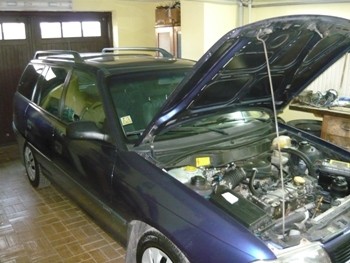
Initially, I was quite skeptical about these revelations and thought that there was another “invention” that advertises and sells well. For the test I applied only to the engine in August 2011. In September, after 3000 km, I checked the compression ratio and was happy to find that on the second cylinder the compression pressure increased to 11.00 kg/cm². On the other cylinders it was different:1.-14.25; 3-15,00; 4-13,00 Kg/cm². The engine was more lively, and LPG consumption decreased by about 0.5 l / 100 km. Encouraged by such an improvement, I used a set of ceramizers: 1 doz each. for the engine, gearbox, power steering and petrol. After 2000 km, I checked the compression ratio and was pleased to find an increase in the compression pressure to 12 kg/cm². On the remaining cylinders as follows: 1-14.25; 3-14.50, 4-13.00 kg/cm². After driving another 4500 km, in January I checked the compression ratio and it was as in the pictures: 1-14.00; 2-12,00; 3-14.00;4-14.00 kg/cm². There was an equalization of pressure on three cylinders without changing on the fourth (second in order). Fuel consumption is lower than in summer up to 0.5 liters on gas. On gasoline fell more, about 1.0-1.5 liters per 100 km! In January, on the route in various conditions, when I ran out of gas, it was about 6.5 l / 100 km. For me, this is a sensational result, because the consumption of gasoline on the route was above 7.5 liters / 100 km. The engine behaves as if it was powered by gasoline, accelerates even in 5th gear (so far I had to reduce). The operation of the engine is quiet and even. The gearbox works quieter, the car rolls longer and does not lose speed so quickly. Starting the engine is hassle-free on a cold or hot engine. Oil consumption is lower, but still high, about 0.7 l/1000 km on semi-synthetic oil. I think it’s the fault of valve sealants, and Ceramizers don’t improve that. I will apply mineral oil, and if this does not help, I will replace the sealants. Encouraged by such results, I decided, after changing the oil, to apply one more dose of Ceramizer to the engine to equalize the pressure on the second cylinder.
For me, Ceramizers turned out to be sensational. I avoided expensive engine overhaul, fuel and oil consumption decreased. The car accelerates nicely and the engine runs quietly. Now driving is a pleasure.
After finding the improvement, I bought Ceramizers for my daughter and son and sent them to Australia. I also recommended to friends from Germany and they are also satisfied with the results and intend to apply them again to the engine and fuel. With a clear conscience, I recommend Ceramizery to others as a proven and worth using product.
Adam Sawicki
Opinion sent on 14-01-2012
